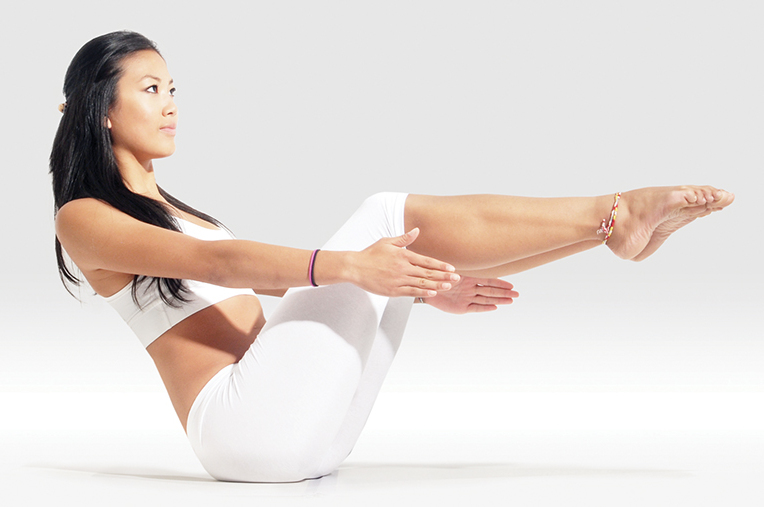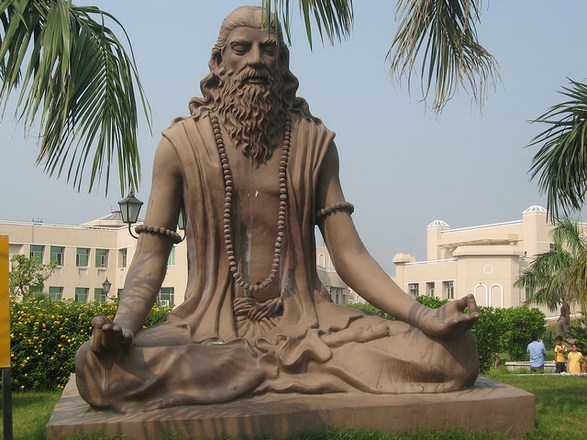 |
Mr. Yoga, CC BY-SA 4.0, via Wikimedia Commons Boat Pose |
The word “Navasana” is derived from the Sanskrit word “Nava,” which means “boat.” This yoga posture is aptly named because when performed correctly, the body takes the shape of a boat—balanced on the sit bones, with the legs and back lifted to form a ‘V’ shape.
Though it might look simple at first glance, this pose offers a powerful combination of strength, balance, and flexibility.
When practicing Navasana (Boat Pose), the practitioner lifts the legs off the ground while maintaining a straight spine, creating a triangular or V-shaped appearance. This posture primarily targets the abdominal muscles, helping to develop core strength, while also engaging the hip flexors, spine, and shoulders.
Despite being a moderately challenging posture for some, Boat Pose is often considered accessible to most yoga practitioners, even beginners, with a little bit of guidance and consistency. Its simplicity in form contrasts beautifully with the profound benefits it offers. It's one of those asanas that doesn't require a great deal of flexibility to begin, making it an ideal posture for anyone looking to enhance their yoga practice and physical fitness level gradually.
How to Do Navasana (Boat Pose)
 |
| Joseph RENGER, CC BY-SA 3.0, via Wikimedia Commons |
- Find Your Starting PositionBegin by sitting comfortably on your yoga mat. Keep your spine straight and shoulders relaxed. Let your hands rest beside your hips. Take a few deep breaths to center yourself before you begin the pose.
-
Leg PositioningExtend both your legs straight out in front of you. Make sure your legs are together and your feet are flexed (toes pointing toward the ceiling).
-
Engage the Core and LiftSlowly begin to lift both legs upward off the ground. Your legs should remain straight as much as possible. Ideally, they should rise to a 45-degree angle or higher, depending on your flexibility and balance. Don’t worry if they bend a little initially—it takes practice.
-
Create the ‘V’ ShapeAs the legs rise, your torso will naturally begin to lean backward. This is where balance and strength come into play. Try not to let the background. Keep your spine straight and chest lifted. Your body should form a ‘V’ shape, with your legs and torso forming the sides of the V.
-
Arm PositionNow stretch your arms forward, parallel to the ground, and aligned with your shoulders. Keep your palms facing each other or upward. Your arms should also be straight and strong, reaching toward your feet.
-
Hold the PoseStay in this position for 15 to 30 seconds to start. As your strength improves, you can gradually increase the duration up to 1 minute or more. Focus on your breath; inhale and exhale slowly and deeply to maintain balance and control.
-
Release the PoseTo release, gently lower your legs and arms back to the floor, and return to the sitting position. You can repeat the posture 2 to 3 times, depending on your energy and fitness level.
Benefits of Navasana (Boat Pose)
Practicing Boat Pose regularly brings a wide array of physical and mental health benefits. While it might look like a simple core exercise, the engagement of multiple muscle groups makes this pose particularly effective.
1. Strengthens Core Muscles
One of the primary benefits of Navasana is the strengthening of the abdominal muscles. Holding the pose requires significant core engagement, helping to tone and build the rectus abdominis (the “six-pack” muscles), transverse abdominis, and obliques. A strong core not only improves posture and stability but also enhances overall physical performance in daily life and sports.
2. Stimulates Digestion
The Boat Pose activates and stimulates the internal organs, particularly the stomach and intestines. This stimulation helps improve digestion and supports the healthy functioning of the digestive system. Practicing this posture regularly can reduce problems like bloating, indigestion, and constipation.
3. Improves Balance and Stability
Balancing on the sit bones while lifting the legs and keeping the back straight requires focus and coordination. Over time, this improves your sense of balance and stability, which are essential for various yoga poses and everyday activities.
4. Strengthens the Hip Flexors and Spine
Navasana engages the hip flexors, which are crucial for lifting and holding the legs in the air. It also gives a mild twist and stretch to the spine, which helps maintain spinal health, flexibility, and strength. With consistent practice, this can help alleviate lower back discomfort caused by weak core muscles.
5. Mental Focus and Endurance
Holding the Boat Pose is not just a physical challenge—it also builds mental resilience. The act of holding a difficult posture requires concentration, control, and steady breathing, all of which improve your ability to focus and remain calm under pressure.
Tips for Safe Practice
While Navasana is relatively accessible, it’s important to approach it with mindfulness and proper form. Here are a few tips to ensure a safe and effective practice:
-
Avoid rounding your back. Try to keep the spine straight and chest lifted.
-
Don’t hold your breath. Maintain a steady and calm breathing pattern throughout.
-
If you’re a beginner, you can bend your knees slightly or hold the backs of your thighs for support.
-
People with lower back pain, hernias, or neck injuries should consult a healthcare provider or experienced yoga instructor before practicing this pose.
 |
Mr. Yoga, CC BY-SA 4.0, via Wikimedia Commons Boat Pose |
Yoga Equipment for Navasana
Yoga Mat
A good yoga mat is essential for all yoga practices, including the Boat Pose. The mat serves not only as a cushion but also as a non-slip surface that gives you the grip and stability you need while doing different asanas. When choosing a mat for poses like Navasana, ensure that:
-
It is firm enough to support your tailbone and spine without sinking too much.
-
It has anti-slip properties to prevent sliding while balancing.
-
The mat should be longer than your height, allowing full-body stretches without feeling cramped.
-
Material should be non-toxic, sweat-absorbent, and durable.
Yoga mats come in various materials like PVC, rubber, or eco-friendly options such as jute and cork. While PVC mats are cheaper, eco-friendly mats are more breathable and sustainable.
Yoga Clothes and Pants
 |
Mr. Yoga, CC BY-SA 4.0, via Wikimedia Commons Boat Pose |
-
Breathability: During intense sessions or hot weather, you’re likely to sweat. Lightweight, breathable fabrics such as pure cotton or bamboo fiber work best for summer yoga practice. They absorb sweat effectively and keep you cool.
-
Flexibility: Your clothes should stretch with your body. Choose yoga pants and tops made with a blend of cotton and spandex or Lycra for flexibility without compromising comfort.
-
Fit: Avoid overly loose clothing that may slide or bunch up, which can become distracting or even unsafe. At the same time, extremely tight clothes can restrict movement or blood flow. Opt for a comfortable, snug fit.
-
Layering: In colder seasons or air-conditioned studios, layering with a light jacket or wrap that you can remove as your body warms up is helpful.
Men and women alike can find specialized yoga gear that includes tank tops, sports bras, high-waisted leggings, or joggers tailored for maximum mobility and sweat management.
Beginner Modifications and Variations
Iveto, CC BY-SA 4.0, via Wikimedia Commons Half boat posture |
-
Bent-Knee Boat Pose: Instead of keeping the legs straight, bend the knees and keep the shins parallel to the ground. This reduces strain and helps you build strength gradually.
-
Use a Wall: Sit near a wall and gently press your back or feet against it for support while lifting your legs.
-
Hold Your Thighs: Grasp the backs of your thighs with your hands for extra support while maintaining the posture.
-
Use a Yoga Strap: Loop a strap around the soles of your feet and hold the ends with your hands to help you maintain the position while keeping your back straight.
Advanced practitioners can try lifting the arms overhead instead of keeping them parallel to the ground or incorporating movement, such as rowing motions or leg scissors, to further challenge the core.
Conclusion
Navasana, or Boat Pose, may look simple, but it holds incredible potential for building core strength, improving balance, and supporting overall physical well-being. Whether you're just beginning your yoga journey or deepening your practice, Boat Pose can serve as a foundational posture for developing discipline, endurance, and mindfulness.
With minimal equipment—a good mat, breathable clothes, and your focused breath—you can incorporate this powerful pose into your daily routine. Start slow, stay consistent, and over time, you’ll feel stronger not only in your body but also in your ability to stay calm and centered through life’s challenges.









